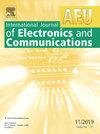Circularly polarized hybrid fractal antenna for Ku band application
IF 3
3区 计算机科学
Q2 ENGINEERING, ELECTRICAL & ELECTRONIC
Aeu-International Journal of Electronics and Communications
Pub Date : 2025-02-01
DOI:10.1016/j.aeue.2024.155641
引用次数: 0
Abstract
This article presents a hybrid fractal microstrip antenna design, referred to as the Vicsekcross & Koch Curve Fractal Antenna (VKFA). The term “hybrid” reflects the integration of two distinct fractal geometries—Vicsekcross and Koch curves—within the same antenna structure. This combination leverages the unique properties of both geometries: the space-filling characteristic of the Vicsekcross fractal, which enhances the effective electrical length for improved miniaturization, and the self-similarity of the Koch fractal, which optimizes bandwidth and gain. The advantages of the proposed hybrid fractal microstrip antenna are enhanced bandwidth, compact size, and enhanced key parameters like gain and efficiency. Finally, it reduces the fabrication cost. The antenna integrates a 2nd order Vicsekcross fractal geometry along with a 2nd order Koch Curve fractal, optimizing its structure for multiband operation and miniaturization. The proposed VKFA covers an operational frequency range from 16.92 GHz to 18.74 GHz, demonstrating a peak gain of 5.14 dBic at 17.19 GHz, with good gain throughout the band. The current vector distribution plot reveals that the antenna features two L-shaped slots positioned 180° apart at the center of the radiating patch to achieve circularly polarized (CP) radiation. By etching these L-shaped slots into the patch, two orthogonal field components are generated, enabling CP characteristics. This occurs due to the establishment of currents on the radiating patch, which results in the formation of two orthogonal modes with a 90° phase shift, essential for CP radiation. The antenna exhibits right-hand circular polarization (RHCP) with a 3 dB axial ratio bandwidth (ARBW) spanning from 17.12 GHz to 18.04 GHz, making it highly suitable for circular polarization applications. The structure is fabricated on an inexpensive FR4 Epoxy substrate with a dielectric constant ( 4.4. The patch antenna achieves compactness, with overall dimensions of 2.18λ0 × 2.18λ0 × 0.09λ0 at a resonance frequency of 17.9 GHz. The Comparative analysis of the measured and simulated results reveals a high level of agreement after the evolution of the antenna’s effectiveness. Due to its compact size, high gain, and broad ARBW, the VKFA can be a suitable candidate for applications in the Ku-band, especially for satellite communications and radar systems.
求助全文
约1分钟内获得全文
求助全文
来源期刊
CiteScore
6.90
自引率
18.80%
发文量
292
审稿时长
4.9 months
期刊介绍:
AEÜ is an international scientific journal which publishes both original works and invited tutorials. The journal''s scope covers all aspects of theory and design of circuits, systems and devices for electronics, signal processing, and communication, including:
signal and system theory, digital signal processing
network theory and circuit design
information theory, communication theory and techniques, modulation, source and channel coding
switching theory and techniques, communication protocols
optical communications
microwave theory and techniques, radar, sonar
antennas, wave propagation
AEÜ publishes full papers and letters with very short turn around time but a high standard review process. Review cycles are typically finished within twelve weeks by application of modern electronic communication facilities.

 求助内容:
求助内容: 应助结果提醒方式:
应助结果提醒方式:


